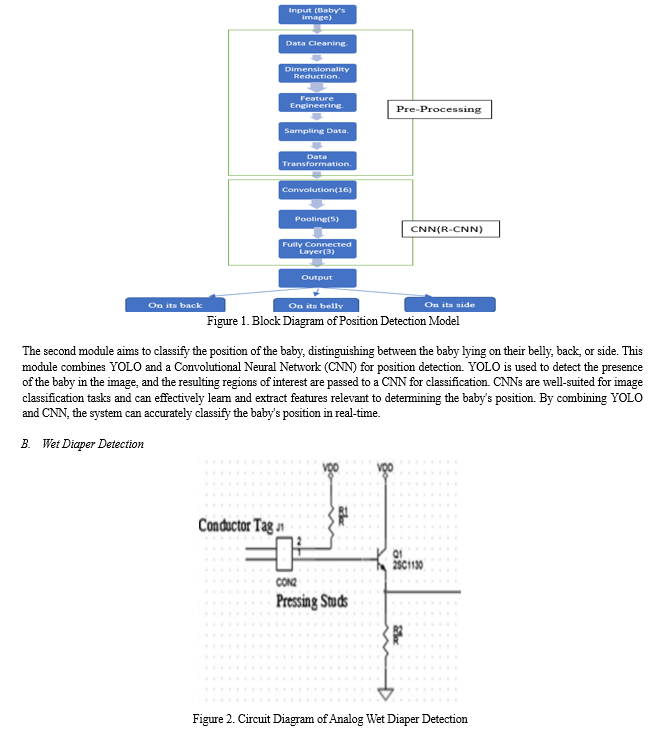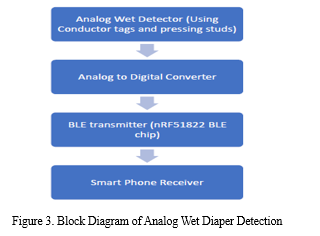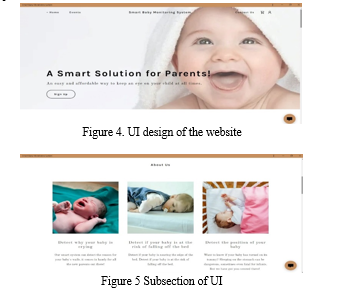Ijraset Journal For Research in Applied Science and Engineering Technology
- Home / Ijraset
- On This Page
- Abstract
- Introduction
- Conclusion
- References
- Copyright
Infant Posture Analyzer and Wet Diaper System
Authors: Hrittick Konar, Amita Patil, Krishna Turkane, Rageshri Bakare
DOI Link: https://doi.org/10.22214/ijraset.2023.52885
Certificate: View Certificate
Abstract
Monitoring the well-being of infants is of utmost importance for ensuring their safety and providing timely care. This paper presents a novel approach to enhance traditional baby monitors by integrating intelligent classification of infant cries and real-time monitoring of sleep positions. The proposed smart baby monitor employs advanced signal processing techniques, machine learning algorithms, and computer vision methods to analyse audio and visual cues, providing valuable insights into a baby\'s needs and sleep patterns. This research paper presents the development of a Smart Baby Monitoring System equipped with one machine learning module and a wet diaper detection model. The system aims to enhance infant safety and improve caregiving practices. The first module employs YOLO and a Convolutional Neural Network (CNN) for position detection, identifying whether the baby is on their belly, back, or side. The position detection model achieves an average accuracy of 90%, with precision and recall rates 85%, ensuring reliable identification of the baby\'s needs Second module is a wet diaper detection module is incorporated to detect if the baby\'s diaper needs changing. The integration of these machine learning modules in the Smart Baby Monitoring System offers real-time monitoring, timely alerts, and improved infant care.
Introduction
I. INTRODUCTION
To address the need for continuous supervision and real-time feedback on an infant's well-being, baby monitoring systems have been developed. These systems utilize a combination of sensors, cameras, communication technologies, and advanced algorithms to capture and analyse data related to the baby's activities. The primary objective of a baby monitoring system is to provide parents or caregivers with peace of mind by enabling remote monitoring and tracking of various aspects of the infant's safety and environment. One of the key challenges faced by parents and caregivers is ensuring the baby's safety and well-being during periods when they need to attend to other responsibilities or when infants are sleeping. A baby monitoring system acts as a technological solution that addresses this challenge. By continuously monitoring the baby's sleep patterns, movements, position, and even vital signs, these systems provide real-time feedback and alerts to parents or caregivers. The benefits of a baby monitoring system are manifold. Firstly, it allows caregivers to detect and respond promptly to potential risks or needs. For example, the system can alert caregivers if the baby rolls over to an unsafe position, leaves the crib, or experiences discomfort. By providing this level of supervision, the system ensures that the baby remains in a safe and comfortable environment. Furthermore, baby monitoring systems contribute to the early detection of potential health issues or abnormalities. By continuously monitoring vital signs or unusual behaviours, caregivers can identify patterns or changes that may require medical attention. This early detection enables timely intervention and promotes the overall health and well-being of the infant.
II. RELATED WORK
Different technologies have been there for the autonomous drone the below table shows the previous works and technologies implemented on this autonomous drone
- The research paper titled "A Low-Cost Wet Diaper Detector Based on Smartphone and BLE Sensor" by MD Saifur Rahman, Chulhyung Choi, Young-pil Kim, Sikyung Kim, and Jungwan Choi (2017) addresses the importance of wet diaper detection for individuals with severe retardation or dementia. It highlights the negative consequences of wet diapers, such as rashes and infections, and the need for continuous monitoring. Existing wet diaper detection systems and sensors are often expensive and complex. Therefore, the authors propose a low-cost smart care system that utilizes a smartphone and Bluetooth Low Energy (BLE) transmitter for wet diaper detection. The system incorporates flexible conductors placed in the most urine absorption area of the diaper. When the diaper becomes wet, the resistance between the two terminals connected with the conductors decreases.
- This decrease in resistance triggers the BLE transmitter to send a warning alarm to a smartphone application, causing the phone to ring. The paper focuses on the integration of BLE technology, a smartphone, and a wet detector system using components such as the nRF51288 and an NPN transistor. By utilizing these low-cost and easily accessible technologies, the proposed system offers a cost-effective solution for wet diaper detection.
- In the research paper titled "An Automated Baby Monitoring System" by Y. Sai Subhash Reddy, Koye Sai Vishnu Vamsi, Golla Akhila, Anudeep Poonati, and Koye Jayanth, the authors address the challenges faced by working parents who are unable to physically care for their infants due to geographical distance. The paper proposes a framework for infant monitoring that utilizes computer vision techniques and sensor data analysis. The framework leverages a Convolutional Neural Network (CNN) to predict the baby's position and detect their movements. It also focuses on identifying specific sounds, particularly crying, to enable parents to assess the baby's condition remotely. The Raspberry Pi is utilized as the central processing unit, continuously processing data from various sensors. The system incorporates a camera module to capture video streams and images of the baby, ensuring constant monitoring. The proposed system aims to monitor the baby's temperature and crying status. The Raspberry Pi B module manages all the connected devices, including IoT modules for capturing videos or photos during abnormal conditions. Sound sensors are employed to recognize the baby's cries, temperature sensors determine the infant's body temperature, and Pi cameras capture the baby's surroundings. These captured data and images can be sent to guardians or parents over the internet. Overall, the authors suggest that the proposed system offers a simplified and convenient solution for busy parents to monitor their infants remotely. By utilizing computer vision techniques, sensor data analysis, and IoT capabilities, the system enables parents to effectively manage and care for their infants even when physically separated from them.
- In the research paper titled "An Intelligent Baby Monitor with Automatic Sleeping Posture Detection and Notification" by Tareq Khan, AI and image processing techniques were utilized to develop a baby monitoring device that can automatically recognize potentially unsafe situations. The device was designed to detect various conditions, including whether the baby's face was covered while sleeping on the stomach, if the baby had thrown off the blanket, if the baby was frequently moving, or if the baby's eyes were open due to awakening. When any of these situations occurred, the monitoring device would send notifications and alerts to the caregiver's smartphone, eliminating the need for constant monitoring. Instead, caregivers would be notified only when their attention was required, providing them with peace of mind. The device was implemented using NVIDIA's Jetson Nano microcontroller, which integrated a night vision camera and Wi-Fi connectivity. Deep learning models were developed and deployed on the microcontroller for pose detection, face recognition, and landmark detection. These models enabled the device to accurately analyze the baby's sleeping posture and detect any potentially risky situations. A prototype of the monitoring device and a corresponding smartphone app were successfully developed and tested under various scenarios. The results demonstrated the effectiveness of the device in automatically detecting and notifying caregivers about unwanted situations, providing an added layer of assurance compared to traditional baby monitors.
- In the research paper titled "Smart Infant-Monitoring System with Machine Learning Model to Detect Physiological Activities and Ambient Conditions" authored by Samira Shamsir, Omiya Hassan, and Syed K. Islam, the authors present the development of an intelligent monitoring system for infants. This system utilizes multiple non-invasive sensors to detect various physiological activities including respiration, movement, noise, and position, as well as ambient temperature and humidity. By collecting and processing data from the different sensor modules, the smart infant monitoring system can generate alarm signals in the event of adverse situations such as apnea, seizures, or uncomfortable environmental conditions. The integration of machine learning models enables the system to analyze the acquired data and identify patterns or anomalies associated with critical events.
The use of non-invasive sensors in this system ensures a safe and comfortable monitoring experience for infants, as it eliminates the need for invasive procedures. Additionally, by considering ambient conditions such as temperature and humidity, the system provides a comprehensive monitoring solution that takes into account the overall well-being of the infant. Overall, the presented research highlights the significance of developing smart infant monitoring systems that combine non-invasive sensors and machine learning techniques. Such systems have the potential to improve infant care and provide caregivers with timely alerts for prompt intervention during critical situations.
III. METHODOLOGY
A. Position Detection Module

The wet diaper detection system works in the following way. Firstly, analog wet detector circuit detects the status of the diaper such as if the diaper is wet sent signal to the ADC (analog to digital converter). Secondly, signal conversion for BLE communication using ADC. After that BLE transmitter sent the warning signal to the pair smart phone.
The fourth part is smart phone receiver and starts alarming sound and upload alert signal into the server for other responsible people. Finally, server sent notification and alarm to the other users. In this study, BLE based Android smart phone application used for making alarm system for our designed wet detector. Firstly, user needs to connect with our wet detector sensor via BLE. After that Android application always read the sensor data, S and compare with the threshold value, P. When the diaper is wet by urine, sensor data fall down than the threshold value. At this moment smart phone starts ringing and upload warning message to the server. The server sends messages the entire user who wants to know the condition of diaper.

C. Software Architecture of The Proposed
System
The proposed Smart Baby Monitoring System encompasses a well-defined software architecture that ensures efficient and reliable operation. The system architecture consists of several interconnected components working together to provide comprehensive monitoring and alerting capabilities. The following sections outline the key components and their interactions within the software architecture.
- User Interface (UI) Module: The User Interface (UI) module serves as the primary interaction point between the system and the user. It provides a web-based interface accessible from any device with a browser. The UI module allows users to monitor the baby's status, view live video feeds, receive alerts, and configure system settings.
- OpenCV: (Open-Source Computer Vision) is an open-source library that provides a wide range of computer vision and image processing functions. It offers a collection of tools and algorithms for tasks such as image and video processing, object detection and recognition, facial analysis, and more. OpenCV allows developers to efficiently manipulate and analyse visual data, extract meaningful information, and perform various computer vision tasks in real-time. It is widely used in applications spanning fields like robotics, surveillance, augmented reality, and medical imaging. Overall, OpenCV simplifies and accelerates the development of computer vision applications by providing a comprehensive set of tools and functions.
- Communication and Integration: The Communication and Integration component facilitates seamless communication between the various system modules. It ensures smooth data flow and coordination among the UI module, Edge Detection module, Position Detection module, Cry Detection module, Wet Diaper Detection module, and Data Storage and Analytics component. Additionally, this component enables integration with external systems or services, such as cloud-based storage or third-party applications.
The proposed software architecture of the Smart Baby Monitoring System provides a scalable and flexible framework for efficient monitoring and analysis. It enables real-time data processing, accurate detection of critical events, and effective communication with caregivers. The modular design allows for easy maintenance, upgrades, and expansion to accommodate future enhancements or additional features.
D. Hardware Architecture of The Proposed
System
The hardware architecture of the Smart Baby Monitoring System is designed to support the efficient and reliable operation of the system components. It comprises several interconnected hardware components that work together seamlessly. The following sections outline the key hardware components and their interactions within the system architecture.
- Raspberry Pi 3B: The Raspberry Pi 3B serves as the central processing unit of the Smart Baby Monitoring System. It is a compact and powerful single-board computer that runs the necessary software modules and handles data processing, communication, and control tasks. The Raspberry Pi 3B provides the computational capabilities required for real-time video and audio processing.
- Night Vision Camera Module: The Night Vision Camera Module is an essential component of the system, responsible for capturing high-quality video footage in low-light conditions. It provides clear and detailed images of the baby's surroundings, enabling accurate edge detection, position detection, and wet diaper detection. The camera module connects to the Raspberry Pi 3B and transmits video data for processing.
- Bluetooth Low Energy (BLE) Module: To enable wireless communication between the Smart Baby Monitoring System and other devices, a Bluetooth Low Energy (BLE) module is incorporated into the hardware architecture. The BLE module facilitates seamless connectivity with smartphones, tablets, or other BLE-enabled devices for remote monitoring and control.
IV. RESULTS
With all the connection and complete model will look like

Conclusion
In conclusion, this research paper presents the development of a Smart Baby Monitoring System that incorporates a machine learning module for position detection and a wet diaper detection model. The system aims to improve infant safety and caregiving practices by providing real-time information and alerts to caregivers. The position detection module accurately classifies the baby\'s sleeping position as belly, back, or side, enabling caregivers to take necessary precautions and minimize potential health risks. The wet diaper detection model monitors the moisture level of the baby\'s diaper, triggering alerts when a diaper change is needed, thus ensuring the baby\'s comfort and hygiene. The integration of advanced hardware components, including a Raspberry Pi 3B and a night vision camera module, enhances the functionality and reliability of the system. Additionally, the system offers remote accessibility through Bluetooth Low Energy (BLE) technology, allowing caregivers to monitor and control the system from their smartphones or tablets. Overall, the Smart Baby Monitoring System presented in this research paper provides caregivers with valuable insights, promoting infant safety and well-being.
References
[1] Automatic Detection of Baby Cry using Machine Learning with Self Learning Music Player System for Soothing - Varsha Dange, Tejaswini Bhosale, Dept. of Multidisciplinary, VIT, Pune [13-04-2022] [2] An Automated Baby Monitoring System - Y Sai Subhash Reddy, Koye Sai Vishnu Vamsi, Golla Akhila, Anudeep Poonati, Koye Jayanth [30-08-2021] [3] Real-Time Object Detection with Yolo - Geethapriya. S, N. Duraimurugan, S.P. Chokkalingam [03-02-2019] [4] Smart Infant-Monitoring System with Machine Learning Model to Detect Physiological Activities and Ambient Conditions - Samira Shamsir, Omiya Hassan, Syed K. Islam [22-05-2020]. [5] Real-Time Object Detection with Yolo - Geethapriya. S, N. Duraimurugan, S.P. Chokkalingam [03-02-2019] [6] B?nic?, H. Cucu, A. Buzo, D. Burileanu and C. Burileanu, \"Baby cry recognition in real-world conditions,\" 2016 39th International Conference on Telecommunications and Signal Processing (TSP), 2016, pp. 315-318, doi: 10.1109/TSP.2016.7760887 [7] J. O. Garcia, and C. R. Garcia,” Mel-frequency cepstrum coefficients extraction from infant cry for classification of normal and pathological cry with feedforward neuralnetworks,” in Proc. Int. Joint Conf. IEEE on Neural Networks, Vol. 4, pp. 31403145, July .2003. [8] Y. Lavner, R. Cohen, D. Ruinskiy and H. Ijzerman, \"Baby cry detection in domestic environment using deep learning,\" 2016 IEEE International Conference on the Science of Electrical Engineering (ICSEE), 2016, pp. 1-5, doi: 10.1109/ICSEE.2016.7806117. [9] Jam MM, Sadjedi H. A system for detecting of infants with pain from normal infants based on multi-band spectral entropy by infant’s cry analysis. In: Second International Conference on Computer and Electrical Engineering. Dubai: IEEE (2009) p. 72–6. doi: 10.1109/ICCEE.200 9.164
Copyright
Copyright © 2023 Hrittick Konar, Amita Patil, Krishna Turkane, Rageshri Bakare. This is an open access article distributed under the Creative Commons Attribution License, which permits unrestricted use, distribution, and reproduction in any medium, provided the original work is properly cited.

Download Paper
Paper Id : IJRASET52885
Publish Date : 2023-05-24
ISSN : 2321-9653
Publisher Name : IJRASET
DOI Link : Click Here
 Submit Paper Online
Submit Paper Online

